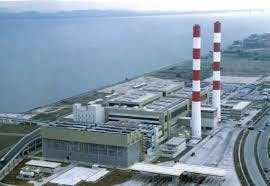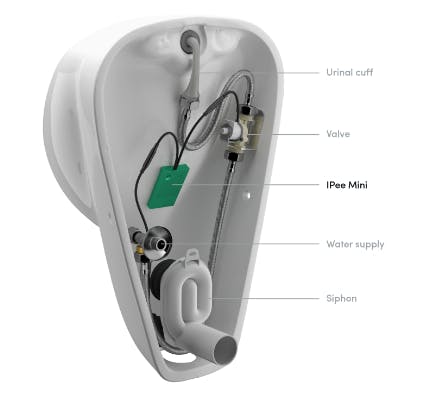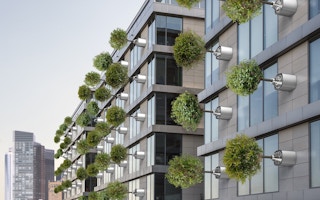Breathing walls that suck smog and exhale clean air. Sensors that can predict the next haze crisis. Horizontally-growing trees, vertical solar panels and smart-tinting window panes. If Asia’s sprawling cities are to continue to thrive as they grow 27 per cent faster than the global average, technology will have to help.
Some 12,000 building professionals and policymakers from 31 countries descended on Marina Bay Sands Expo and Convention Centre from 5-7 September for the Build Eco Xpo at Singapore Green Building Week to see how technology can help the built environment weather a rising army of challenges, from congestion and air pollution, to rising temperatures, flooding and water insecurity.
Here are a few of the tech innovations that caught Eco-Business’ eye.
Sideways-growing trees
It looks like the world has been turned on its side. Or by some quirk of science, trees no longer grow up but sideways, cheating gravity and bowing away from the sun.

GraviPlants growing indoors. Image: Viseoverdislant
Actually, explains biologist Dr Alina Schick, managing director of Visioverdis, the German firm behind GraviPlant, it’s more like the latter. Her trees are planted in pots clamped to the sides of building facades. The pots rotate. The movement ‘tricks’ the trees into growing sideways. Vorsprung durch technik in urban greening.
Because they are constantly revolving, Visioverdis’ sideways trees are exposed to more sunlight than regular trees, so they are bushier. In fact, they have about double the biomass of regular trees, says Schick. This means that they can filter more pollutants from the air, fix more carbon and produce more oxygen. They also have a cooling effect. A building facade with greenery on is about twice as cool as a concrete surface, Schick says.
But don’t they use a lot of energy? A single unit uses 30 watts of power from a computer that automates rotation, irrigation and lighting. But that’s offset by the cooling effect of the trees, Schick says.
But aren’t they super expensive? Though they are fairly self-sustaining and only need to be pruned twice a year, GraviPlants do not come cheap. A single unit costs €9,900 (US$14,400). Offices, conference centres, banks, hotels and the occasional rich home owner are the target market. But think about the PR value, says Schick, who has chosen Singapore as the first Asian country to market GraviPlants. “You would get enormous media attention if you were the first to plant a horizontal forest,” she says.
Inside-out umbrellas
At first glance, this elegant structure looks like the super trees at Gardens by the Bay have had a baby.
Which they sort of have. Singapore’s futuristic horticulture park will be the first place outside of India that this sustainable canopy, developed by husband-and-wife entrepreneurs Priya Vakil Choksi and Samit Choksi, pops up in the city-state.
The PHI 1080 is a quadri-purpose canopy that provides shade, solar-powered lighting, harvests rainwater, and charges your phone while you sit under it.

The PHI 1080 canopy. Image: ThinkPHI
The mast of the canopy contains USB ports for charging, but its main function is as a filter for cleaning rainwater that funnels down from the canopy. The mast is connected to an underground plumbing network, which can draw on the rainwater when needed. The mast also contains intelligent controls that automatically adjust the lighting levels, depending on the time of the day, and a window in the mast allows people to gaze at the rainwater harvesting process.
The PHI 1080 is lightweight, wind-resistant and uses high-grade steel, saving time and cost on installation and maintenance.
Yap Su Chii, director of food-saving non-government group Zerowaste Food, told Eco-Business: “The PHI 1080 canopy looks deceivingly simple. But it incorporates sustainable design elements such as harnessing solar and rainwater. Not only is it aesthetically pleasing, it is functional and can be easily installed anywhere and everywhere.”
The smart toilet

The IPee urinal sensor can be fitted to existing urinals, without the need to buy new sanitary ware. Image: IPee
One of the most irritatingly wasteful inventions of modern times has to be the auto-flush toilet. They never seem to flush at the right time—sometimes before you enter the toilet cubicle, sometimes before you’ve finished your business. According to one study in the United States, when auto-flush toilets replaced manual commodes, water use increased by 54 per cent.
Enter the IPee, an intelligent toilet sensor that flushes only when it needs to, and with an appropriate amount of water.
This sustainable urinal sensor, developed by a Belgium startup, is able to detect the salt content in urine, and flushes only when urine is present. It can also recognise blockages in the urinal, and switch itself off to prevent flooded bathrooms.
“What’s particularly innovative about the IPee is the watersaving stadion mode, which is automatically activated when lots of people are constantly using the urinal. The volume of water per flush reduces, which saves water,” said Xie Yu, an architecture student from the Singapore University of Technology and Design.
Future incarnations of IPee salt-detecting technology could be fitted in showers and washing basins so that they can be operated without having to turn a tap or a handle—useful for elderly or disabled bathroom users.
The hand-drying tap
Dyson, the British company famous for its vacuum cleaners, has invented a tap that not only washes but dries your hands. As you don’t need a separate hand dryer, you avoid waste water dripping on the floor, so less resources are needed for cleaning, and you save on wall and floor space.

The Dyson Airblade Tap. Image: Dyson
You also save on paper and energy, and the unit only costs around US$34 a year to run. Which is just as well with a price tag of S$2373 (US$1,721) for an individual tap. The Dyson Airblade Tap does away with the need for paper towels, and uses less energy than regular hand dryers. Dyson Airblade Taps dry hands quicker, and produce about 4 grams of carbon dioxide per dry—up to 74 per cent less than other hand dryers, the company says. This is because of a motor that spins up to three times faster than most hand drying motors.
These dryers are also more sanitary, as a filter cleans the air before it dries your hands.
















